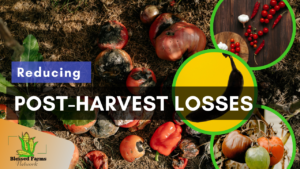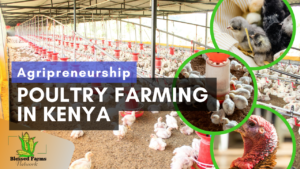Introduction
Farming has become synonymous with fertilizers.
As such, studies show that over 48% of groundwater sources in the world are yearly contaminated by nitrates from synthetic fertilizers, causing significant risks to the environment and human health. In Kenya, nitrate contamination is linked to high cases of methemoglobinemia, which leads to “blue baby Syndrome” due to low oxygen in the blood. This, and other issues associated with fertilizer, has pushed farmers to seek an alternative that is safer and not degrading the health of the soil.
Natural alternatives like composting have never been more needed. Composting offers an eco-friendly means to enrich the soil while protecting the public health. This article aims to act as a guide to farmers interested in instigating composting systems in their farms. It will offer a step-by-step guide on how to set up your composting pit, the materials needed, and the financial implications of this technique.
Knowledge of composting is necessary for the development of sustainable farming systems in Kenya.
What is Composting?
There has been a growing concern over soil health, lack of biodiversity, air pollution, and land degradation, pushing for organic recycling techniques in farming. Compositing is such a technique, and it involves the utilization of agricultural wastes to naturally decay through the action of fungi and worms to produce partially digested humus. Organic materials like vegetable cuttings, leaf twigs, and recycled agricultural wastes like cow dung, straw, and rice husks are placed in ideal environments for micro-organisms action to break them down into compost, a product that is then used as organic fertilizer to improve the nutrients in soils. Compost is a rich source of organic matter.
The availability of organic material in soil enhances the quality of soil making it more appropriate for farming. Compost is also known to improve the physico-chemical and biological properties of the soil. The result is more resistance to stress through drought, increased capability for nutrient intake, and a higher nutrient cycling capacity. These are the advantages that all farmers are seeking as they culminate in higher yields, lower outlays, and reduced cropping risks.
Composting is based on the technology of decomposing. Based on the nature of the decomposition there are two types of composting: aerobics and anaerobic
Anaerobic Composting
Anaerobic composting is when decomposition occurs in an area deprived of oxygen. It utilizes anaerobic microorganisms, leading to the accumulation of the developed intermediate compounds such as hydrogen sulfides, organic acids, and methane. These compounds are not metabolized further, but rather they accumulate. These compounds have strong odors and can be phytotoxic. Another disadvantage is that things like weeds, seeds, and pathogens remain interact and are not decomposed. The process takes longer.
Aerobic Composting
this is where decomposition occurs in the presence of oxygen, and thus use aerobic micro-organisms. It leads to the production of carbon-dioxide, ammonia, heat and humus, a relatively stable organic end product. any intermediate compound like organic acid is broken down further to decompose them. The heat produced during the process accelerates the breakdown of different components thus making this process faster. This, though might be a limitation as the heat can lead to the loss of some nutrients.
Vermicomposting
This is a technology of composting using earthworms. The worms eat the organic waste and excrete nutrient-rich casting which can be used as fertilizer. This product is clean, odorless and more effective in composting that other technologies. It is seen to accelerate organic matter stabilization and provide phyto-hormonal and chelating elements that have a high microbial matter content.
Benefits of Composting for Kenyan Farmers
Composting has numerous benefits to the farmer, to human health and to the environment.
It leads to the production of organic fertilizer that is used as an alternative to in-organic fertilizer that has negative effects on human health and environment.
- There is reduced emission of methane and other greenhouse gases
- It reduced soil degradation that normally occurs due to continuous use of chemical fertilizers.
- There is no water pollution, as the nutrients from composting are more stable and released in a slower rate allowing plants to absorb them better thus reducing leaching.
There is a considerable reduction of costs on the farmers
- Farmers shot relying on chemical fertilizers, thus reducing the cost of using fertilizer in their farms.
- Organic fertilizers lead to healthier crops and higher production
- Support farming in wetland, reforest and revitalized habitants due to its impact on the soil.
Composting has positive impacts on the environment.
- The health of soil is greatly improved, with the structure improving, increased water retention rate and a higher nutrient content.
- Composting uses waste, thus there is reduced waste in the environment.
- Composting helps to sequester carbon.
Materials Needed for Composting in Kenya
Organic Material
In composting organic material should be a combination of green and brown stuff.
Green materials include young weeds, manure from cows, rabbits, chickens, or grass cuttings. You can also include fruits, vegetable scraps, and other green waste. They are high in nitrogen and activate the heat process of composting. Green materials like egg shells, crushed livestock bones, and feathers can be added to increase the nutritive nature of the compost.
Brown materials include dried leaves, sawdust straws, hay, and dried weeds. These materials are high in carbon and serve as the fiber for the compost.
To quicken the process of decomposition, it is necessary to break down this material, both the green and brown materials into small size.
Air
In case a farmer aims to carry out anaerobic composting, they can deprive the materials oxygen. This will push for the thriving of aerobic micro-organism. As stated above this technique is slower and produces unstable components and has a bad odor.
To promote aerobic micro-organism, a farmer must allow the heap to continually access oxygen and expel carbon-dioxide. Farmers are advised to include rough organic materials like twigs between the heaps to allow effective circulation of air in the heap. They should also continually turn the heap. In case of a foul smile, add more brown material to open up the structure.
Water
Water is necessary for micro-organism to live and spread through the heap. Water management is necessary; a heap that is too wet prevents effective air transmission thus leading to the death of the micro-organisms. If the heap is too dry the micro-organism will also die. If too dry add more green matter or water. If too wet add more brown material.
Soil or Starter Compost
Though no compulsory, it is necessary to add soil or previous composted material between the layers to ensure presence of appropriate bacteria. It also pushes the composting process to begin.
Step-by-Step Composting Strategy for Kenyan Farmers
Step 1: Selecting a Compost Site
A compost should have the following characteristics: –
- A flat area with good drainage to prevent water pooling.
- There should be partial shade to prevent excess drying.
- It should also have easy access to check and add necessary materials continually.
Composting can be done on wooden boxes or open plastic drums. These are the most appropriate for small-scale farmers who do not have huge lands to make composting sites. Further, these items can be customized as per the farmer’s needs. There must be ventilation, where small holes can be drilled into the drum, or wooden slates to allow airflow. Further, the bottom and top should be open. The bottom should be in direct contact with the soil to allow microorganisms and earthworms to enter into the pile and start decomposition. Otherwise, micro-organisms and earthworms(vermiculture). The open is to allow you to add material. But it should have a removable lid that prevents entry of pests and excess rain and sunlight.
Step 2: Layering the Materials
Proper layering is necessary for effective decomposition.
- Start with rough dry materials (twigs /straws) at the bottom.
- Then add the green matter
- Add a layer of dirt, or starter compost if available. Also add wood ash or lime to add nutrients.
- Add the brown matter
- Alternative green and brown matter at the ratio of 30 parts green matter and 25 parts brown matter.
- Moisten the layers if need be
- Cover the compost pile with a tarp or black plastic to help retain heat.
- The pile should be turned every few days to help aerate.
Tip: Avoid adding meat, oily foods, or plastics as they attract pests and slow decomposition.
Step 3: Maintaining the Compost
Consistent care is essential to produce quality compost.
- Turning: Make sure to turn the pile every week to keep it aerated as this speeds up the process of decomposition.
- Watering: Keep the pile moist but not soggy. If it’s too dry, sprinkle water. If too wet, add more browns.
- Monitoring: Check for a healthy, earthy smell. Bad odors indicate an imbalance (too many greens or poor aeration).
From the eighth day, you should stick a stick into the middle of the heap. If it is hot, that is a good sign that decomposition is taking place. If not, add more manure and mix the other material.
Step 4: Management and Harvesting the Compost
In the process of turning, the material will start turning into dark crumbly material that has an earthy smell. This means that the compost is ready for use on the farm. Once removed from the compost pit, the post-harvesting process should start.
- remove any undecomposed pieces and return them to the next season of composting.
- Sieve to remove any worms that are still in the pile, the remaining component should be pure compost.
- The worms can be fed to the chicken.
- The compost can then be spread in the field evenly or mixed with soil in seedlings and potted plants.
- It can also be stored in airtight bags for future use.
Vermicomposting

Composting can occur through natural means. This process can be slow, and thus the introduction of vermicomposting, which utilizes earthworms to break down the organic wastes.
Unlike the other setup that needs to be touching the soil, the vermicomposting bed is placed a few centimeters from the ground, with a chicken mesh placed at the bottom of the composting bucket, tank, or box. The mesh is to ensure efficient air ventilation. the rest of the setup and layering are similar, though the earthworms are released into the moist beds.
Continuous maintenance of the pile should be carried out to ensure that the worms are well. The temperature should be maintained by covering the pit with a dark polythene plastic. Predators like ants should also checked to ensure they do not enter into the pit.
When the compost is ready, the worms need to be harvested and the compost processed. The worms can be reused in another composting process or fed to fish and poultry. More on vermiculture (the process of raining earthworms for composting and other uses) will be discussed in another article.
Conclusion
For any farmer that is seeking to instill sustainable solutions in their farm, composting is a must have. It can solve numerous issues that farmers are experiencing like soil degradation, high input costs, and water pollution due to the use of synthetic fertilizers. Compost enriches the soil, boosts crop yields, and protects the environment. Further, it gives an opportunity to recycle organic waste material efficiently while turning it into a product that is valuable. The process of composting is not expensive and can be viewed as a worthy investment. Take a step today. Identify a location within your farm to carry out composting, gather the required material, and start your first composting pit using natural micro-organisms and bacteria. If possible, create a vermicomposting system. The benefits are undeniable.





